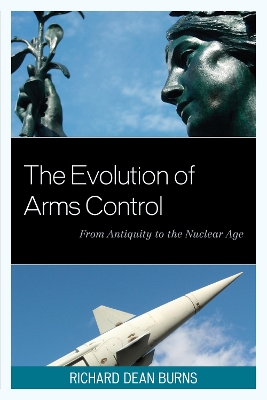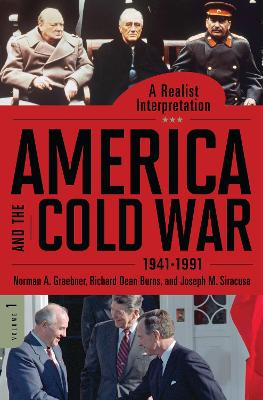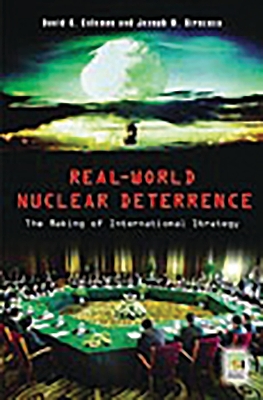Praeger Security International
9 total works
Arms control and disarmament measures have been pursued and adopted throughout the history and prehistory of human warfare: sometimes as protocols recognizing evolving humanitarian taboos; sometimes as terms imposed by the victors on the vanquished; and sometimes as accords negotiated between rivals fearful of mutual destruction. Arms control measures ramped up in significance and urgency at the dawn of the 20th century by the introduction of rapid-fire weapons, aircraft, chemical agents, and submarines, and again at mid-century with the advent of weapons of mass destruction-nuclear, chemical, and bacteriological-with sophisticated delivery systems. As Burns makes clear, the enormous increase in destructive potential brought about by thermonuclear weaponry essentially changed the nature of war and, therefore, of arms control.
America and the Cold War, 1941-1991: A Realist Interpretation
by Norman a Graebner, Richard Dean Burns, and Professor Joseph M Siracusa
This volume reviews the debates surrounding the anti-ballistic missile (ABM) defense systems and their deployment by George W. Bush, allowing readers to assess for themselves the significance of Bush's decisions.
The Missile Defense Systems of George W. Bush: A Critical Assessment asks and answers a number of pressing questions about Bush's decision to deploy ground-based missiles. Has the system become reliable? If not, what are the prospects for it to become effective? What have the fiscal costs been? What was the political impact of efforts to expand ABM systems to Europe?
This is the only major book that brings together all of the factors-historical and current-to allow readers to assess President Bush's decisions for themselves. Opening with an extensive history of missile defense, the book analyzes Bush's efforts to establish ground-based missiles in Eastern Europe, as well as the impact of his decisions. Both the administration's policies and evaluations and those of critical observers are presented. President Obama's program for missile defense is reviewed as well. A final chapter evaluates the technical progress of the various ABM systems and weighs the political dimensions of the deployment decision and the cost of the undertaking to date.
A Global History of the Nuclear Arms Race [2 volumes]
by Richard Dean Burns and Joseph M. Siracusa
Written by two preeminent authors in the field, this book provides an accessible global narrative of the nuclear arms race since 1945 that focuses on the roles of key scientists, military chiefs, and political leaders.
The first book of its kind to provide a global perspective of the arms race, this two-volume work connects episodes worldwide involving nuclear weapons in a comprehensive, narrative fashion. Beginning with a discussion of the scientific research of the 1930s and 1940s and the Hiroshima decision, the authors focus on five basic themes: political dimensions, technological developments, military and diplomatic strategies, and impact.
The history of the international nuclear arms race is examined within the context of four historical eras: America's nuclear monopoly, America's nuclear superiority, superpower parity, and the post-Cold War era. Information about the historical development of the independent deterrence of Britain, France, and China, as well as the piecemeal deterrence of newcomers Israel, India, Pakistan, and North Korea is also included, as is coverage of the efforts aimed at the international control of nuclear weapons and the diplomatic architecture that underpins the global nuclear non-proliferation regime.
- Makes the case that nuclear weaponry gradually assumed political stature and came to dominate high-level diplomatic activity
- Describes inherent problems posed by various delivery systems of nuclear weaponry
- Draws connections between military strategy and nuclear arms control efforts as well as anti-missile systems
- Identifies and assesses post-Cold War issues in dealing with nuclear terrorism
The Missile Defense Systems of George W. Bush: A Critical Assessment
by Richard Dean Burns
America and the Cold War, 1941-1991 [2 volumes]
by Norman a Graebner, Richard Dean Burns, and Joseph M. Siracusa
Three distinguished diplomatic historians offer an assessment of the Cold War in the realist tradition that focuses on balancing the objectives of foreign policy with the means of accomplishing them.
America and the Cold War, 1941-1991: A Realist Interpretation is a sweeping historical account that focuses on the policy differences at the center of this conflict. In its pages, three preeminent authors offer an examination of contemporary criticism of the Cold War, documenting the views of observers who appreciated that many policies of the period were not only dangerous, but could not resolve the problems they contemplated.
The study offers a comprehensive chronicle of U.S.-Soviet relations, broadly conceived, from World War II to the collapse of the Soviet Union. It places the origins of the Cold War as related to the contentious issues of World War II and stresses the failure of Washington to understand or seriously seek settlement of those issues. It points out how nuclear weaponry gradually assumed political stature and came to dominate high-level, Soviet-American diplomatic activity, at the same time discounting the notion that the Cold War was a global ideological confrontation for the future of civilization. A concluding chapter draws lessons from the Cold War decades, showing how they apply to dealing with nation-states and terrorist groups today.
- A bibliography
- A chronology
- Photos and illustrations
A Global History of the Nuclear Arms Race: Weapons, Strategy, and Politics [2 Volumes]
by Richard Dean Burns and Professor Joseph M Siracusa
The threat of nuclear weapons did not fade away with the collapse of the Soviet Union. Rather, the geopolitical disorders of the post-Cold War era and the rise of global terrorism have ensured that they remain conspicuously present on the world stage as a serious international concern. With the eight or nine nuclear powers maintaining about 27,000 nuclear weapons in their arsenals to this day, it is clear that they are here to stay for the foreseeable future. The primary mission of these nuclear forces has been and remains deterrence. Using plain language rather than policy jargon, this historically focused book shows how nuclear deterrence has worked rather than how it should. It then shows how the growing threat of nuclear proliferation threatens to create a far more complicated international situation largely because of the attendant proliferation of state nuclear deterrents.
By drawing on a wide array of new sources from international archives and the latest in international scholarship, Coleman and Siracusa put some of the most important and enduring problems of nuclear deterrence over the past sixty years into global context. Nuclear deterrence in the real world often operates very differently from how it should according to the prevailing theories, and Coleman and Siracusa take a fresh look at how nuclear weapons policy has been made, finding that it often has had surprisingly little to do with what works and what does not. By studying in depth how governments here and abroad have confronted and dealt with some of the most important issues in nuclear weapons policy, for example, How many nuclear weapons are enough? and What is it that will deter? they find that the making of nuclear weapons policy is a complex, fluid bargaining process subject to the tides of politics, budgets, threat perception, ideology, technology, parochial service rivalries, flawed information, and sometimes just plain wishful thinking.



![Cover of A Global History of the Nuclear Arms Race [2 volumes]](https://images.bookhype.com/covers/28/ca/915751f5-ee9b-42c6-b472-7580283fac82/9781440800948-44a228248e04273f9172e5.jpg)

![Cover of America and the Cold War, 1941-1991 [2 volumes]](https://images.bookhype.com/covers/f8/4b/91576465-3a84-48ea-97f4-46956cc8b48f/9780313385254-1572b4a5f5471ea94e0cf2.jpg)
![Cover of A Global History of the Nuclear Arms Race: Weapons, Strategy, and Politics [2 Volumes]](https://images.bookhype.com/covers/61/67/9157673a-228d-42ae-a671-cb076f897616/9781440800955-fcf15f545c0b578a673dbf.jpg)
